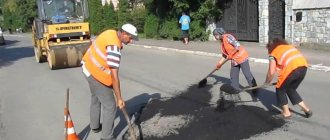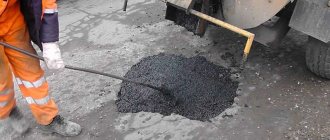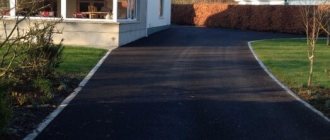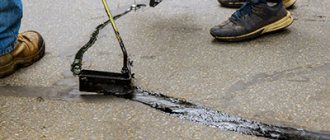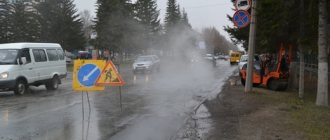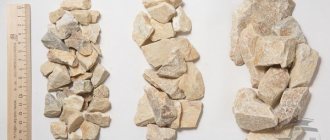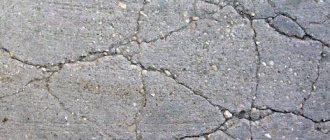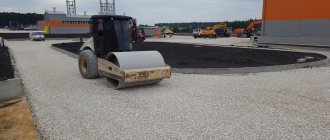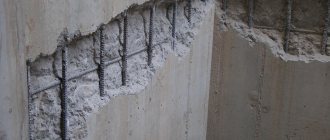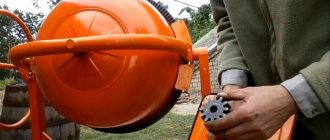Sooner or later, regardless of its quality, all asphalt coverings of roads and sidewalks are destroyed. Various defects appear in them: holes, potholes, cracks.
Damage to asphalt can be caused by a number of factors:
- Violation of coating laying technology
- High traffic loads
- Destructive effects of water, ice, chemicals
- Frequent temperature changes
- Aging of organic binder - bitumen
If defects are not corrected in a timely manner, the service life of asphalt is rapidly reduced. After all, through cracks and potholes, water enters the thickness of the material, which negatively affects its strength. And when it freezes, it expands and bursts the coating from the inside.
In this article we will look at all the main local repair methods that are used on roads and private areas. We will also examine in detail the technology for filling holes with our own hands. And in the final sections we’ll talk about how long it takes to fix potholes on the roads and how to distinguish a quality patch from a hack job.
If you are looking for information on how to prevent the destruction of the coating in its infancy, then check out the article Mastics and sealants for asphalt - how to repair a crack in asphalt.
Content:
- Why is it difficult to repair potholes in cold weather?
- Is asphalt patching allowed in winter?
- Types of pothole work
- Cold asphalt
- Hot mix
- Cast asphalt
- Cast asphalt concrete mixture (ABS) and semi-finished briquettes
- Features of patching asphalt pavement in winter
The winter period of the year is not the best time for road work. But if the condition of the road surface is a real problem for moving vehicles, and it poses a real threat to life, you cannot do without pothole repair of the asphalt pavement in winter. It is carried out very often. In this case, a number of nuances and technological features must be observed.
Thermal profiling
Machine and road repair using thermal profiling
One of the most modern and effective repair technologies. It is used not only to repair defects, but also to restore coatings that have lost their properties due to a long service life or other factors.
The technology is based on heating and regenerating asphalt concrete, or applying an additional layer on top. In addition to eliminating cracks and potholes, rutting and pavement subsidence are removed. In order to perform thermal profiling of asphalt concrete pavements, you need a set of machines or a combined unit.
It includes:
- Infrared burners for heating asphalt.
- Loosening devices.
- Mixing devices.
- Rollers for laying.
- Dispensers for added mixture or components.
Depending on the condition of the old pavement, the characteristics of its destruction and other factors, one of the methods for restoring asphalt concrete is chosen.
Thermoplasticization
No new mixture is added. Before laying, old asphalt is mixed with a plasticizer that restores its properties.
Remix
The old asphalt is mixed with the new mixture. Aggregates or binders are also added as needed.
We have given the causes of destruction, types of repairs (major, current emergency), and all the most used asphalt repair technologies today. Of course, the topic is not completely closed, but we will be glad if our article helped you or simply expanded your circle of knowledge.
Why is it difficult to repair potholes in cold weather?
Snow, ice, and water naturally accumulate in potholes, making them difficult to remove. Patches can be a temporary solution to the problem, but they must fit snugly to the edges of the coating and be laid on a well-dried surface. Otherwise, the remaining moisture will expand as it freezes, causing cracks to appear.
Patches are only effective when installed correctly. In winter, they do not have time to cool down, stick to the tires and are pulled out by them, washed out by rains and floods, and destroyed due to rubbing of accumulated water.
The best conditions for asphalt work are when the temperature reaches 20-22 C°. But even if you don’t like the idea of starting them in December or January, in some cases you shouldn’t wait, because this can provoke:
- Additional damage caused by the freeze/thaw cycle
- Risk of injury to pedestrians or damage to vehicles.
- Possibility of water seeping under asphalt
- Refusal of customers to use parking lots or highways.
Causes and classification of road damage
Any discrepancy between the characteristics of the asphalt concrete pavement and the expected or required properties violates the integrity and technologically correct functioning of the object, which subsequently leads to destruction of the road surface.
Types of damage
Types of defects in asphalt concrete pavement are associated with a whole range of different factors:
- Structural (design) defects appear as a result of erroneous calculations during design, violation of technical specifications and incorrect application of regulatory documentation.
- Manufacturing defects are associated with a discrepancy between the actually implemented technical solutions (road slope, width of the roadbed, etc.) and the requirements of the developed design documentation.
- Technological - caused by violations of technological instructions, non-compliance with the rules and procedures for performing work.
- Operational - arise during the operation of the roadway and are the result of natural aging of the surface, wear, the influence of weather and climatic conditions, the impact of traffic loads, etc.
To determine the scale of violations, the defectiveness coefficient is used - this is the weighted average volume of damage per 1 m2 of surface.
Classification of possible structural violations
Destructions and plastic deformations of highways can be divided into two categories - coating defects, and damage with subsequent destruction of road pavements as a whole.
The most common damage to the roadway structure:
subsidence is a distortion of the road profile in the form of depressions with flat edges;
Drawdown
track - deformation of the transverse profile of the roadway along the run-up line;
Track
breaks - thorough destruction of the structural layers of the coating with a sharp deformation of the transverse profile;
Broken canvas
spalling - damage to the coating due to the loss of parts of the mineral material;
Crumbling of asphalt concrete pavement
destruction of edges - collapse of the outer cut of road surfaces in places where they meet the roadsides;
Edge Fracture
open cracks - linear untreated damage with a gap width of 3 mm or more.
Opened cracks
Coating surface defects include the following:
shears - displacement of structural layers, usually on steep slopes or in braking areas;
Shift
waves - alternation of elevations and depressions on the surface in the longitudinal direction relative to the central axis of the road;
Waves
peeling - consistent destruction of the surface as a result of peeling off thin flakes of material;
Peeling
potholes - defects in the form of depressions with sharply defined edges (depth 3 cm or more);
Pothole
cracks (single, mesh) - longitudinal, intersecting, transverse breaks, randomly located on the surface without any pattern.
Mesh of cracks
Is asphalt patching allowed in winter?
A question that interests many motorists. The legislation allows for repairs of canvas down to -10 C° and possible precipitation in the form of rain or snow in moderate quantities. In some regions of the country, snow cover remains for more than six months, which does not eliminate the need for regular road maintenance and asphalt patching.
But at the same time, a number of adjustments are made to the technological process. When creating a mixture, various types of plasticizers and hardeners are necessarily used; they increase fluidity and do not allow it to harden too quickly in frost. It is not recommended to lay it in a very thick layer to avoid changing the technical parameters.
Cold asphalt
During its creation, a component is added that, when asphalt is stored hermetically, does not allow it to harden and increases the viscosity to the required values. Laying is carried out at a composition temperature of at least 5 C° and an ambient temperature of at least –25 C°. The movement can begin immediately after the process is completed.
One of the disadvantages of the material is its low level of shear resistance, and therefore its use is advisable on roads with no traffic jams. It should not be used to repair intersections and traffic stops. But intense traffic will only strengthen the compaction and make the coating as durable as possible.
The advantages of such asphalting:
- long shelf life of ready-made formulations, which allows you to create the necessary stock;
- low-temperature laying limit, allowing work to be carried out in any region of the country;
- movement along the road section can begin immediately after completion of the repairs;
- no special road equipment is required during installation.
The disadvantage can be considered high cost, inability to use in large recesses, and fairly rapid destruction if laid loosely.
Preparatory operations
Before carrying out work, the following preparatory operations are performed:
- Site fencing, road signs and lighting devices are installed when work is carried out in the dark.
- Repair locations (maps) are marked using chalk or a stretched cord. The repair map is drawn with straight lines perpendicular and parallel to the axis of the road, giving the correct shape to the contour and capturing the undamaged surface.
- Damaged coatings are cut down, broken or milled, and the removed material is removed. It is carried out to the thickness of the destroyed coating layer, but not less than 4 centimeters along the entire length of the repair. When a pothole affects the bottom layer, it is loosened and removed to its full thickness.
- Potholes are cleared of material residues, dirt and dust.
- The walls and bottom are dried when performing repairs using the hot method.
- The walls and bottom are treated with bitumen or bitumen emulsion.
Hot mix
If there are asphalt concrete plants nearby that produce hot asphalt, it is better for them to carry out pothole repairs in winter. This takes into account the natural features of the climate, the duration of winter, the depth of soil freezing, and the average value of winter temperature indicators. The amount of frozen soil should not be more than 70%, its maximum thickness should not be more than 30 cm. The estimated height of the subgrade in the presence of frost is no more than 2.5 m.
The main condition is to maintain +80 C° heat in the building material. When preparing the pothole, you must first trim it, thoroughly clean and prime it, warm it well, and only then paving. Compliance with all technologies ensures longer subsequent operation of the road. In addition, in cool times the material cools faster, which means that traffic in this area will be restored in about half an hour.
CALCULATION of labor costs for the installation of asphalt concrete pavement
| Name of works | Unit | Scope of work | Standard time | Price per unit. measured | total cost | ||
| per unit measured | per volume | ||||||
| 1 | 2 | 3 | 4 | 5 | 6 | 7 | 8 |
| 2-1-5l, 6b | Cutting the vegetation layer with a bulldozer under the base of the road | 1000 m2 | 1 | 1,95 | 1,95 | 1-37 | 1-37 |
| 2-1-26, t. 2, 1b | Laying out the roadbed with a motor grader during a working stroke in 2 directions | -«- | 1 | 0,175 | 0,175 | 0-138 | 0-14 |
| 20-2-3, vol. 2, item 1b | Construction of a drainage ditch | 100 m3 of compact soil | 3 | 2,2 | 6,6 | 1-74 | 5-22 |
| 20-2-12, vol. 1, item 2b | Construction of a trough in the roadbed using grader D-144 | -«- | 2 | 1,25 | 2,50 | 0-98,8 | 1-98 |
| 2-1-22, t. 7, p. 1c | Compacting the bottom of the trough with trailed rollers weighing up to 3 tons with four passes along one track | 1000 m2 | 1 | 0,88 | 0,88 | 0-618 | 1-24 |
| Application Calculation No. 1 | Transportation of sand by dump trucks with its distribution along the length of the trough, with a transportation range of 15 km | 1 t | 320 | 0,32 | 102,4 | 0-205 | 65-60 |
| 2-1-20, t. 2, p. 2d | Leveling sand with bulldozer D-271 | 100 m3 in dense dimension | 3 | 1,7 | 5,1 | 1-06 | 3-18 |
| 20-2-14, clause 3a | Compaction of the sandy underlying layer in a trough with a trailed roller with 4 passes along one track | 1000 m2 | 1 | 0,88 | 0,88 | 0-552 | 0-552 |
| Application Calculation No. 1 | Delivery of crushed stone by dump trucks with its distribution along the length is dense and along the side of the road | T | 500 | 0,32 | 160 | 0-205 | 102-50 |
| 17-1, paragraph 7 | Leveling crushed stone with a motor grader D-144 | 100 m2 | 10 | 0,155 | 1,55 | 0-12,2 | 1-22 |
| 17-26 | Final layout of the bases for rolling | -«- | 10 | 1,6 | 16 | 0-822 | 8-22 |
| 17-11 | Rolling crushed stone base with a roller weighing up to 10 tons | -«- | 10 | 1,65 | 16,5 | 1-16 | 11-60 |
| Preparatory work | |||||||
| 20-2-28, clause 1a | Cleaning a gravel or crushed stone base from dust and dirt using a PM-VOS watering machine with a mechanized brush at a speed of 8 km/h with 8 passes across the width of the area | 100 m2 | 7,0 | 0,025 | 0,175 | 0-016 | 0-112 |
| 20-2-28, clause 4b | Cleaning the gravel or crushed stone base from dust and dirt by sweeping with brooms in places inaccessible to machinery (we assume roughly 30% of the total volume) | -«- | 3,0 | 2,1 | 6,3 | 0-92 | 2-76 |
| 17-26a, paragraph 1 | Filling of binding materials with a manual distributor D-125A with additional heating | 1 t | 0,5 | 8,6 | 5,1 | 4-51 | 2-26 |
| 17-29, paragraph 2, 5 | Trimming and manually trimming crushed stone or gravel base | 100 m base edge | 5 | 2,8 | 14 | 1-38 | 5-52 |
| Bottom layer device | |||||||
| Application Calculation No. 1 | Transportation of asphalt concrete mixture by dump trucks with an average hauling distance of 15 km with unloading at the base (with a layer thickness of 5 cm per 100 m2, 12.4 tons of asphalt concrete with a volumetric weight of 2.34 t/m3 are required) | T | 124 | 0,32 | 39,7 | 0-20,5 | 25-42 |
| 17-23 t. 2, 2g | Manual distribution of asphalt concrete mixture | 100 m2 | 10 | 5,9 | 59 | 3-26 | 32-60 |
| 17-12, paragraph 22 | Rolling of asphalt concrete mixture with 5 t motor rollers with 4 passes along one track | -«- | 10 | 0,27 | 2,7 | 0-19 | 1-90 |
| 17-12, paragraph 24 | Rolling of asphalt concrete mixture with a 10 t motor roller with 17 passes along one track | -«- | 10 | 0,91 | 9,1 | 0-639 | 6-39 |
| Top layer device | |||||||
| Application Calculation No. 1 | Transportation of asphalt concrete mixture by dump trucks with an average hauling distance of 15 km with unloading onto the base (with a layer thickness of 4 cm per 100 m2, 9.0 tons of asphalt concrete with a volumetric weight of 2.38 t/m3 is required) | T | 96,9 | 0,32 | 31 | 0-205 | 19-86 |
| 17-28, vol. 2, 2g | Manual distribution of asphalt concrete mixture | 100 m2 | 10 | 5,9 | 59 | 3-26 | 32-60 |
| 17-12, paragraph 23 | Rolling of asphalt concrete mixture with motor rollers weighing 5 tons with 8 passes along one track | -«- | 10 | 0,56 | 5,6 | 0-393 | 3-93 |
| 17-12, paragraph 24 | Rolling an asphalt concrete mixture with a motor roller weighing 10 tons with 17 passes of the roller along one track | -«- | 10 | 0,91 | 9,1 | 0-639 | 6-39 |
| 17-21 | Strengthening roadsides with crushed stone or gravel | 100 m2 of curbs | 5 | 0,71 | 3,85 | 0-490 | 2-45 |
Coating surface finishing | |||||||
| 20-2-27 | Warming up porous areas of the coating and areas that cannot be corrected with an asphalt iron (accepted conditionally 1% of the total volume) | 1 m2 | 10 | 0,16 | 1,6 | 0-089 | 0-89 |
| 17-28 | Adding asphalt concrete mixture in correction areas | 100 m2 | 0,1 | 4,7 | 0,47 | 2-60 | 0-26 |
| 17-12, approx. 1 | Additional compaction of porous areas after heating and adding the mixture with a motor roller weighing 10 tons with 4 passes along one track | -«- | 0,1 | 0,22 | 0,022 | 0-156 | 0-0156 |
| 17-61 | Cutting samples from asphalt concrete pavement with sealing of cutting areas measuring 250×250 mm at the rate of one cutting per 100 m2 of pavement | 1 place | 10 | 0,52 | 5,2 | 0-289 | 2-89 |
| 1-11, paragraph 3b, | Loading waste asphalt concrete onto a vehicle manually after cutting off the edges | 1 t | 2 | 0,492 | 0-984 | 0-216 | 0-432 |
| k = 1, 2 | 567,45 | 349-49 |
Cast asphalt
It is a hot substance consisting of bitumen of good viscosity. Once poured, it compacts on its own as it cools; no roller is required for this. The temperature of the laid material should not be less than +200 degrees, so special delivery conditions are required.
Cast asphalt is convenient for eliminating minor defects in the road surface - cracks, small dents, etc.
Cast asphalt concrete mixture (ABS) and semi-finished briquettes
Perfect for large-scale pothole repairs in winter. They are prepared right before use or created in advance and then stored as semi-finished briquettes. To produce ABS, a certain amount of bitumen is heated in a boiler, sand, crushed stone and mineral powder are added to it in portions. Over the course of several hours, the contents are mixed and brought to +230 C°. Delivered to the desired location in a thermal bunker.
Briquettes do not contain mineral powder; they are prepared in the fall using molds. After complete hardening, they are packaged in polyethylene and stored in a cool room. As needed, heat in small batches in a thermal hopper.
Advantages of cast ABS:
- does not require compaction, and acquires all the necessary qualities during the cooling process;
- ideal adhesion to the asphalt surface under the most unfavorable conditions;
- high plasticity threshold;
- simplicity of the filling process;
- possibility of emergency recovery in both heat and cold.
The main disadvantages are the use of special equipment that maintains temperature readings during delivery. In zhaou, the performance characteristics of the canvas deteriorate, it softens and causes subsidence.
Features of patching asphalt pavement in winter
In the cold season, the thickness of the laying increases by about 1 cm and on average is at least 5 cm. To create mixtures, a larger amount of bitumen is given. Delivery is carried out by transport that provides protection from cooling.
Compaction is carried out by various types of rollers or manual equipment if the area being repaired is small.
To prepare the map, it is not recommended to use a jackhammer to avoid the appearance of microcracks, various chips, and potholes. Cutting equipment is best for preparation. Pits with a depth of at least 10 cm are sealed immediately, laying the material in one layer. Smaller holes are pre-deepened.
It is better to do pothole repairs in winter in calm weather. If the wind speed is more than 5 m/s and the frost is quite severe, the work should be postponed until better weather conditions.
All stages of asphalt restoration in winter should be coordinated as much as possible by all structures involved in the process. An important role is played by the clear organization of production, delivery, distribution and compaction of building materials, and careful preparation of the map.
Safety precautions
When carrying out construction work, you must be guided by the following documents:
— Safety rules in construction (SNiP III-A.11-70);
— Rules for the design and safe operation of load-lifting cranes (M.: Metallurgy, 1976).
Particular attention should be paid to the following:
— all preparatory and mechanized work must be carried out under the direct supervision of engineering and technical workers appointed by order;
— the construction site must be provided with a first aid kit with medicines and drinking water;
— workers servicing machines must have the required orange workwear, special footwear for working with hot materials and gloves;
— workers are prohibited from being in an overturned dump truck body and rocking it when unloading the mixture is difficult;
— motor rollers must be equipped with a device for lubricating the rollers and a canopy over the driver’s workplace, and have a working sound signal;
— when several rollers operate sequentially, the distance between them must be at least 5 m;
— only the operator should turn on the roller engine. The engine should be started with late ignition;
- Do not start an overheated engine;
— when changing the direction of movement of the roller, it is necessary to give a warning signal;
— tools used for finishing asphalt concrete pavements using a hot mix must be heated in a mobile brazier. It is prohibited to heat the instrument over fires;
— it is strictly forbidden to finish the coating (grouting porous mixtures) in front of a moving roller.

